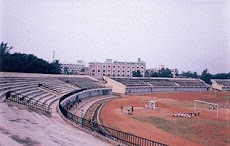BENEFITS OF TARA PUJA
-
Goddess #TARA gives ultimate knowledge, power, wealth & salvation.
Ekakshari Tara Mantra(ॐ त्रीं/Om Treem)
Worshiping Maa with devotion protect us from
*...
5 years ago
 Author, Researcher, Activist & Associate Editor- New Delhi.
Authored & Co-Authored several Books on History, Culture and Society for various Universities,
Associated with Odisha Development Forum as its President & working for the development of the Tribal dominated backward Districts of Odisha.
Author, Researcher, Activist & Associate Editor- New Delhi.
Authored & Co-Authored several Books on History, Culture and Society for various Universities,
Associated with Odisha Development Forum as its President & working for the development of the Tribal dominated backward Districts of Odisha.
 The university authorities have also proposed to replace
overhead electrical lines with underground cables and massive plantation to
restore Bhanja Vihar's lush green campus. Located near Gopalpur-on-Sea, Bhanja
Vihar was badly damaged as Phailin made its landfall just a few km away on
October 12. The authorities were forced to extend Puja vacation till November
18 as the university was in no position to conduct the classes early. "We
have restored only 10% of damaged structure and need a special package to
rebuild Bhanja Vihar," said vice-chancellor (VC) Deepak Kumar Behera on
Saturday.
The university authorities have also proposed to replace
overhead electrical lines with underground cables and massive plantation to
restore Bhanja Vihar's lush green campus. Located near Gopalpur-on-Sea, Bhanja
Vihar was badly damaged as Phailin made its landfall just a few km away on
October 12. The authorities were forced to extend Puja vacation till November
18 as the university was in no position to conduct the classes early. "We
have restored only 10% of damaged structure and need a special package to
rebuild Bhanja Vihar," said vice-chancellor (VC) Deepak Kumar Behera on
Saturday.
 Author, Researcher, Activist & Associate Editor- New Delhi.
Authored & Co-Authored several Books on History, Culture and Society for various Universities,
Associated with Odisha Development Forum as its President & working for the development of the Tribal dominated backward Districts of Odisha.
Author, Researcher, Activist & Associate Editor- New Delhi.
Authored & Co-Authored several Books on History, Culture and Society for various Universities,
Associated with Odisha Development Forum as its President & working for the development of the Tribal dominated backward Districts of Odisha.
 Author, Researcher, Activist & Associate Editor- New Delhi.
Authored & Co-Authored several Books on History, Culture and Society for various Universities,
Associated with Odisha Development Forum as its President & working for the development of the Tribal dominated backward Districts of Odisha.
Author, Researcher, Activist & Associate Editor- New Delhi.
Authored & Co-Authored several Books on History, Culture and Society for various Universities,
Associated with Odisha Development Forum as its President & working for the development of the Tribal dominated backward Districts of Odisha.
 Author, Researcher, Activist & Associate Editor- New Delhi.
Authored & Co-Authored several Books on History, Culture and Society for various Universities,
Associated with Odisha Development Forum as its President & working for the development of the Tribal dominated backward Districts of Odisha.
Author, Researcher, Activist & Associate Editor- New Delhi.
Authored & Co-Authored several Books on History, Culture and Society for various Universities,
Associated with Odisha Development Forum as its President & working for the development of the Tribal dominated backward Districts of Odisha.
 The
agitation to achieve a railway link to Kandhamal district from Berhampur in
Ganjam district will be intensified through democratic means, the Relapatha
Sangram Samity of Kandhamal district, which is spearheading the agitation, has
said. As part of its stepped up efforts to achieve its demand, the organisation
decided to rope in people of Ganjam district. The organisation has, therefore,
been renamed as ‘Relapatha Sangram Samity, Kandhamal-Ganjam’. The extended
organisation held its first meeting in the city on Sunday to chalk out its
future plans. It was attended by its president Sriya Kumari Nayak, secretary
Subash Chandra Sahu, and social activists from Ganjam and Kandhamnal districts.
The
agitation to achieve a railway link to Kandhamal district from Berhampur in
Ganjam district will be intensified through democratic means, the Relapatha
Sangram Samity of Kandhamal district, which is spearheading the agitation, has
said. As part of its stepped up efforts to achieve its demand, the organisation
decided to rope in people of Ganjam district. The organisation has, therefore,
been renamed as ‘Relapatha Sangram Samity, Kandhamal-Ganjam’. The extended
organisation held its first meeting in the city on Sunday to chalk out its
future plans. It was attended by its president Sriya Kumari Nayak, secretary
Subash Chandra Sahu, and social activists from Ganjam and Kandhamnal districts. Author, Researcher, Activist & Associate Editor- New Delhi.
Authored & Co-Authored several Books on History, Culture and Society for various Universities,
Associated with Odisha Development Forum as its President & working for the development of the Tribal dominated backward Districts of Odisha.
Author, Researcher, Activist & Associate Editor- New Delhi.
Authored & Co-Authored several Books on History, Culture and Society for various Universities,
Associated with Odisha Development Forum as its President & working for the development of the Tribal dominated backward Districts of Odisha.
 |
| Photo credit: Gopal Krishna Reddy, The Telegraph |
 Author, Researcher, Activist & Associate Editor- New Delhi.
Authored & Co-Authored several Books on History, Culture and Society for various Universities,
Associated with Odisha Development Forum as its President & working for the development of the Tribal dominated backward Districts of Odisha.
Author, Researcher, Activist & Associate Editor- New Delhi.
Authored & Co-Authored several Books on History, Culture and Society for various Universities,
Associated with Odisha Development Forum as its President & working for the development of the Tribal dominated backward Districts of Odisha.
 Author, Researcher, Activist & Associate Editor- New Delhi.
Authored & Co-Authored several Books on History, Culture and Society for various Universities,
Associated with Odisha Development Forum as its President & working for the development of the Tribal dominated backward Districts of Odisha.
Author, Researcher, Activist & Associate Editor- New Delhi.
Authored & Co-Authored several Books on History, Culture and Society for various Universities,
Associated with Odisha Development Forum as its President & working for the development of the Tribal dominated backward Districts of Odisha.
 Author, Researcher, Activist & Associate Editor- New Delhi.
Authored & Co-Authored several Books on History, Culture and Society for various Universities,
Associated with Odisha Development Forum as its President & working for the development of the Tribal dominated backward Districts of Odisha.
Author, Researcher, Activist & Associate Editor- New Delhi.
Authored & Co-Authored several Books on History, Culture and Society for various Universities,
Associated with Odisha Development Forum as its President & working for the development of the Tribal dominated backward Districts of Odisha.

 Visitors from the USA, Canada, Italy, Korea, Britain, Germany and Belgium have been visiting the town after normalcy was restored after the Phailin battered the sea resort on October 12. The lighting system has been restored in the beach on a priority basis for the convenience of the tourists, said Gopalpur Notified Area Council Executive Officer R Mishra.
Visitors from the USA, Canada, Italy, Korea, Britain, Germany and Belgium have been visiting the town after normalcy was restored after the Phailin battered the sea resort on October 12. The lighting system has been restored in the beach on a priority basis for the convenience of the tourists, said Gopalpur Notified Area Council Executive Officer R Mishra. Author, Researcher, Activist & Associate Editor- New Delhi.
Authored & Co-Authored several Books on History, Culture and Society for various Universities,
Associated with Odisha Development Forum as its President & working for the development of the Tribal dominated backward Districts of Odisha.
Author, Researcher, Activist & Associate Editor- New Delhi.
Authored & Co-Authored several Books on History, Culture and Society for various Universities,
Associated with Odisha Development Forum as its President & working for the development of the Tribal dominated backward Districts of Odisha.
 Author, Researcher, Activist & Associate Editor- New Delhi.
Authored & Co-Authored several Books on History, Culture and Society for various Universities,
Associated with Odisha Development Forum as its President & working for the development of the Tribal dominated backward Districts of Odisha.
Author, Researcher, Activist & Associate Editor- New Delhi.
Authored & Co-Authored several Books on History, Culture and Society for various Universities,
Associated with Odisha Development Forum as its President & working for the development of the Tribal dominated backward Districts of Odisha.
 Author, Researcher, Activist & Associate Editor- New Delhi.
Authored & Co-Authored several Books on History, Culture and Society for various Universities,
Associated with Odisha Development Forum as its President & working for the development of the Tribal dominated backward Districts of Odisha.
Author, Researcher, Activist & Associate Editor- New Delhi.
Authored & Co-Authored several Books on History, Culture and Society for various Universities,
Associated with Odisha Development Forum as its President & working for the development of the Tribal dominated backward Districts of Odisha.











.jpg)

















































